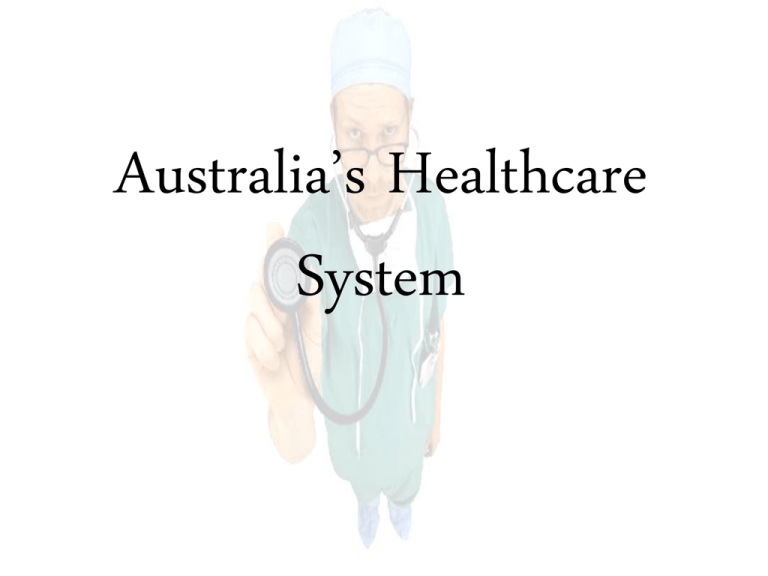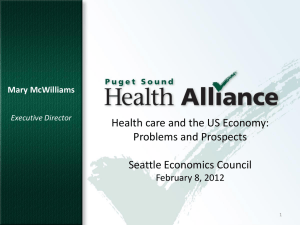Australias Health care System
advertisement

Australia’s Healthcare System A quick overview.. Australian Healthcare’s aim The aim of the national healthcare funding system is to provide all Australians access to healthcare at no cost, or at an affordable cost, whilst also allowing choice for individuals through a private sector. GDP and Trend in health care expenditure comparison In comparison to $78,598 million spent on healthcare in 2003 - 04 Australia’s health expenditure has grown from $0.7 billion, 3.8% of GDP, in 1960-61 to $103.6 billion, 9.1% of GDP in 2007-08. The main areas of expenditure in 2007-08 were : - hospitals $38,557 million - public hospital services $30,817 million, - private hospitals $7,740 million - medical services $18,338 million (18.7%) - medications $13,720 million (14.0%) - dental services $6,106 million (6.2%) - community health $5,195 million (5.3%) - other health practitioner services $3,373 million (3.4%) Healthcare funding When it comes to who funds Australia’s healthcare the Commonwealth, State and Territory government, health insurers and individuals are the providers. Commonwealth Government In relation to the healthcare system, the Commonwealth Government is responsible for the provision of healthcare which impacts all Australians. Some of the funding includes: -Financial support to government and non-government health organisations - Financial support for state governments for public hospital system - Management of National Health Programs - Control of Pharmaceuticals - Establishing and maintaining food regulations through Food Standards Australia and New Zealand The Commonwealth Government funds $9,000 million to public hospitals The Commonwealth Government not only funds public hospitals but contributes $3,000 million to private hospitals The total cost of PBS prescription drugs dispensed from community pharmacies each year is nearly $3.9 billion. The Commonwealth pays around 83% of this cost. State Government The state governments, via their departments of each health sector, provide guidance and direction to local authorities as well as providing a wide range of health services. These services involve: - Registering private hospitals, medical practitioners and other health professionals - Many healthcare programs, ranging from pre-natal health to rehabilitation - Preventative and early detection programs - Conducting research into public health issues - Provision for information and education programs promoting health through government agencies. The State Government contributes $19,000 million to public hospitals The State Government provides $4,500 million to high level residential care The State Government funds approximately $1,500 million to dental services Local Government The local governments have a responsibility to provide a healthy and safe environment for their community. Some services provided by the local councils aim to achieve this responsibility by: - Organising healthcare programs - Implying provision of community services - Trying to maintain a sanitary environment The local governments also - Providing safe water supply contribute to the $4,500 million provided to high - Upholding public safety on the roads level residential care - Development of recreational and cultural facilities - Operating home care services As well as the State Government, the local government contributes $2,500 million to private hospitals Medicare Medicare Values What is it? Medicare is a major part of the national healthcare system which provides high quality healthcare which is both affordable and accessible to all Australians. Anyone over 15 years of age may be enrolled on their own Medicare card. When was it introduced? It was introduced by the Commonwealth Government in 1984 with the aim to provide access to healthcare at little or no cost at all to Australians who are in need of treatment. -Equity - Accessibility - Universality - Efficiency - Simplicity - Affordable How is it funded? Medicare is largely financed from general taxation revenue, based on a person’s taxable income. - Quality care - People who earn up to $50,000 and families who earn up to $100,000 contribute 1.5% of their income to Medicare, those who earn little are exempt. - Those with higher incomes pay an additional 1% of their income, unless they have private health insurance - Health Promotion - Free choice What does Medicare cover? Medicare covers a variety of services, both in-hospital and out-of-hospital. Some of the services which are covered by Medicare includes: - Doctor’s consultation fees - Many diagnostic tests – x-rays and blood tests - Most surgical procedures – treating illness and eye tests - Specialists (specified services only) Being covered by Medicare mean that these services are available to patients for little or no cost. What doesn’t Medicare cover? There are also come health services which Medicare doesn’t cover. These services which aren’t covered by Medicare include: - Private hospital costs -Dental examinations and treatments - Ambulance services - Medications as well as complementary and alternative medicines - Glasses and contacts - Hearing aids and other appliances - Medical cost incurred overseas - Medical services which are not clinically needed Private Healthcare Insurance What is Private Healthcare Insurance? Australians are entitled to receive treatment as a public treatment at no personal cost, private health insurance can be taken out to cover a range of healthcare services that are not covered by Medicare. -Private health insurance helps relieve the pressure on public hospital systems and helps reduce waiting list. - It is in the governments best interest for people to take out private health insurance. What does Private Healthcare cover? There are two main types of private healthcare Insurance these include Private Hospital Cover and Extras or Ancillary cover. -Private hospital cover offers patients access to private hospitals and the opportunity to select their own doctor to treat them in hospital. - Ancillary cover covers out-of-hospital services which are not covered by Medicare, these services may include dentistry and physiotherapy. Private Health Insurance - NIB NIB is one of the many private sector insurances available which is accessible and affordable for all Australians. NIB was established over 50 years ago, nib has experienced significant national market growth since 2002. What does NIB offer? NIB offers a variety of packages of health cover to suit your situation whether you may be single, in a relationship, have a family or are over 55. I have researched the family basic saver which provides families with great value health insurance for families who need health cover mostly for the kids. Costs? The family basic saver starts at $26.58 per week. The benefits of this package include: - Hospital and Extras health insurance - 50% back on Extras, so if your provider charges $200 you will initially get $100 back Private Health Insurance - NIB In the Family Basic Saver it covers a wide range of services provided under hospital cover, but, it also reveals exclusions in order to help customers identify what the insurance covers and what it doesn’t. It also provides information about the extras included in order for families to choose the right cover suiting their families needs. The family basic saver would be of benefit to my situation right now as I am living under my family roof. This cover is aimed at providing sufficient cover for children, which, in my circumstance is beneficial as I do not pay for my healthcare, my parents do. This private healthcare insurance covers my optometrist and orthodontist appointments, as well as glasses and braces. Government encouraging Private Health Insurance Why would the government encourage Private Health Insurance? The Government encourages Private Health Insurance in order to relieve the pressure on the public hospital system as well as reducing waiting lists. How is the government doing this? In order to persuade families and individuals the government introduced Private Health Insurance Incentive Schemes. In January 1999, the 30% rebate scheme was introduced for all those who pay private health insurance, no matter their income, was eligible. Those with private health insurance were also exempt from the additional Medicare surcharge levy of 1% to encourage people who can afford it to take it out. In July 2000, the government introduced the lifetime health cover incentive which aims to encourage people to take out private insurance before July 1st following their 30th birthday. Those who obtain private health insurance after they are 30 will pay an additional 2% levy each year over the age of 30 until they join. Pharmaceutical Benefits Scheme What is the Pharmaceutical Benefits Scheme? The Australian Government provides subsidised prescription drugs to residents of Australia to ensure that all Australians have affordable and reliable access to a wide range of necessary medicines. When a customer is prescribed with a drug, in order to receive Pharmaceutical Benefit it must listed in the Schedule of Pharmaceutical Benefits. The subsidy is automatically applied when the drug is dispensed to pharmacies so when the medication is bought by the patient it is the patient co-payment rather than the full cost of the medication. How does the Pharmaceutical Benefits Scheme benefit the public? - This Benefit Scheme helps Australians to lead longer and healthier lives creating the PBS to grow every year. - With the use of PBS Australians are able to enjoy access to cost efficient medicines, now and for the future. The PBS covered around 171 million prescriptions in the year to June 2008. From 1 January 2009, you pay up to $32.90 for most PBS medicines or $5.30 if you have a concession card whilst the Australian Government pays the remaining cost. The cost of the PBS is currently around $7 billion per year. Around 80% of prescriptions dispensed in Australia are subsidised under the PBS .







